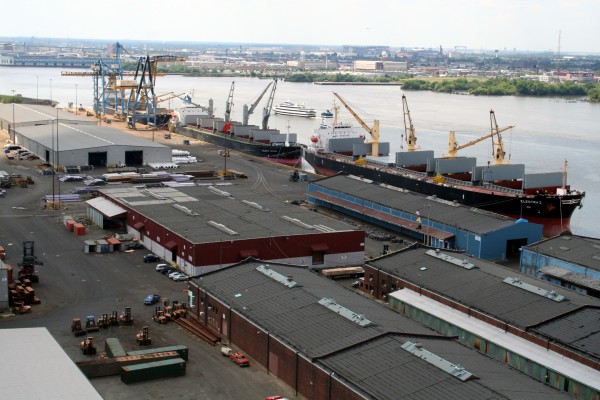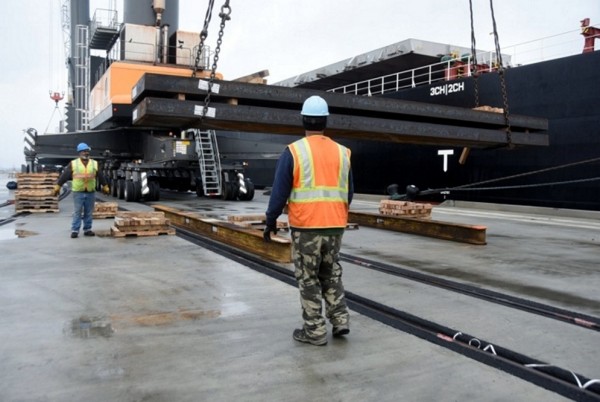Having opened the initial portion of its Paulsboro Marine Terminal and with a bond issue offering funding for development of the second and final phase of the facility, the South Jersey Port Corp. is well-positioned to continue to break cargo records on the New Jersey side of the Delaware River.
“It’s been a very active, good year,” SJPC’s deputy executive director, facility security officer, public information officer and board secretary, Jay Jones, told AJOT, reflecting on 2016. “We’ll be moving like gangbusters this year to build two additional ship berths and a barge berth.”

Designed by CH2M HILL and operated by Holt Cargo Systems Inc. on a former BP tank farm site across the Delaware River from Philadelphia International Airport, the Paulsboro Marine Terminal has the distinction of being the first major such development along the Delaware River in more than half a century.
It’s already bustling with activity, spearheaded by steel slabs imported from Russia by NLMK USA and destined for transport by daily 75-car unit trains to mills in Western Pennsylvania and Indiana.
The terminal’s activity should see a further boost when Paulsboro gets the additional berths, the longest of which is to be 950 feet, and other new infrastructure, including asphalt paving of 57 more acres, some 10,000 feet of additional fencing, high-mast lighting, an expanded gate complex and enhanced rail connections.
“That will pretty much finish the terminal,” Jones said in regard to the second-phase work.
The SJPC closed in December on a $255 million subordinated marine terminal revenue bonds sale, with $175 million of the proceeds to go toward the additional work at Paulsboro. The terminal’s first phase was funded largely by way of $175 million in earlier SJPC bonds, issued in 2009.
The remaining $80 million or so from the latest bonds are earmarked for improvements at the SJPC’s two longtime facilities in Camden – the Joseph A. Balzano Marine Terminal (formerly the Beckett Street Terminal) and the Broadway Marine Terminal. Projects include maintenance dredging at both locations and erection of a 100,000-square-foot warehouse at the Broadway facility, designed to accommodate steel, as well as wood products and general cargos. In fact, import steel, including coils, has been a longtime leading commodity moving over Camden docks.

Import steel made up about one-third of the total tonnage moved through South Jersey terminals in calendar 2017, during which, when tallies are finalized, should come to about 4.2 million tons, leaving in the dust the prior SJPC record of 3.8 million tons, set in 2006.
SJPC terminals also enjoyed a healthy season for cocoa bean imports, with the 86,000 tons of that good coming through South Jersey in the first 11 months of 2017 already more than double the 36,000 tons handled in all of 2016. The activity was stimulated by a strong growing season in Ghana and other source countries on the West Coast of Africa, while demand was high at local chocolate producers including M&M Mars, Blommers and Hershey’s.
SJPC’s 1.7 million dry bulk tonnage figure included 688,000 tons of scrap metal moving through the 122-acre Balzano facility for Camden Iron & Metal Inc., while commerce via the Broadway docks included the Lehigh Cement operation’s import of 432,000 tons of furnace slag and export of 203,000 tons of related cement products.
The fourth SJPC terminal, the 28-acre Salem Marine Terminal, is a hub for U.S. Concrete.
“We don’t have any container throughput,” Jones, who joined the SJPC executive contingent in 1991, pointed out. “We developed over decades to focus on breakbulk and dry bulk.”
Jones said the SJPC looks to concentrate in 2018 upon the efforts to bring the Paulsboro facility to full fruition, upgrading Camden facilities, enhancing intermodal connections and greater promotion and marketing of Foreign-Trade Zone No. 142, for which the SJPC is grantee.





